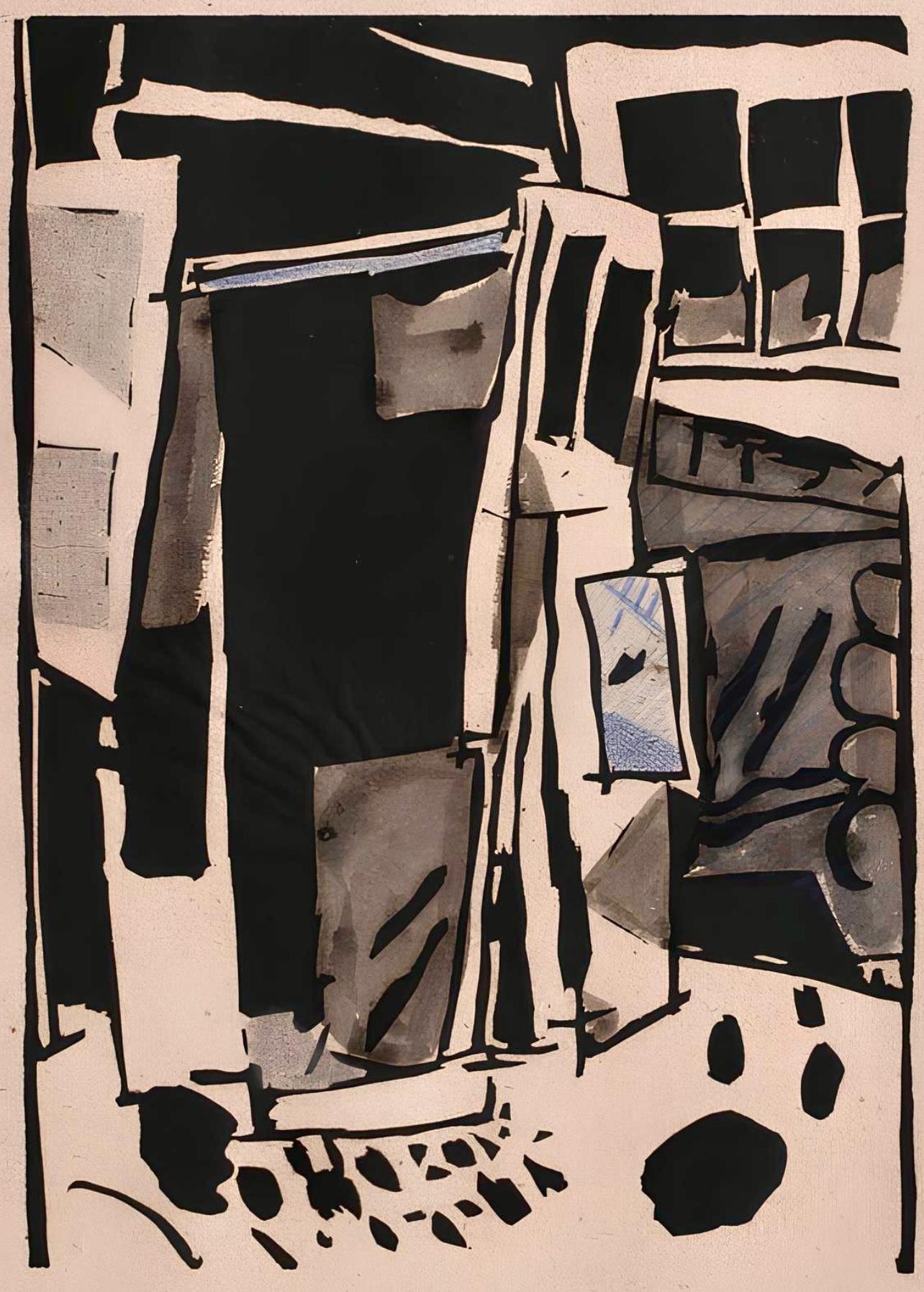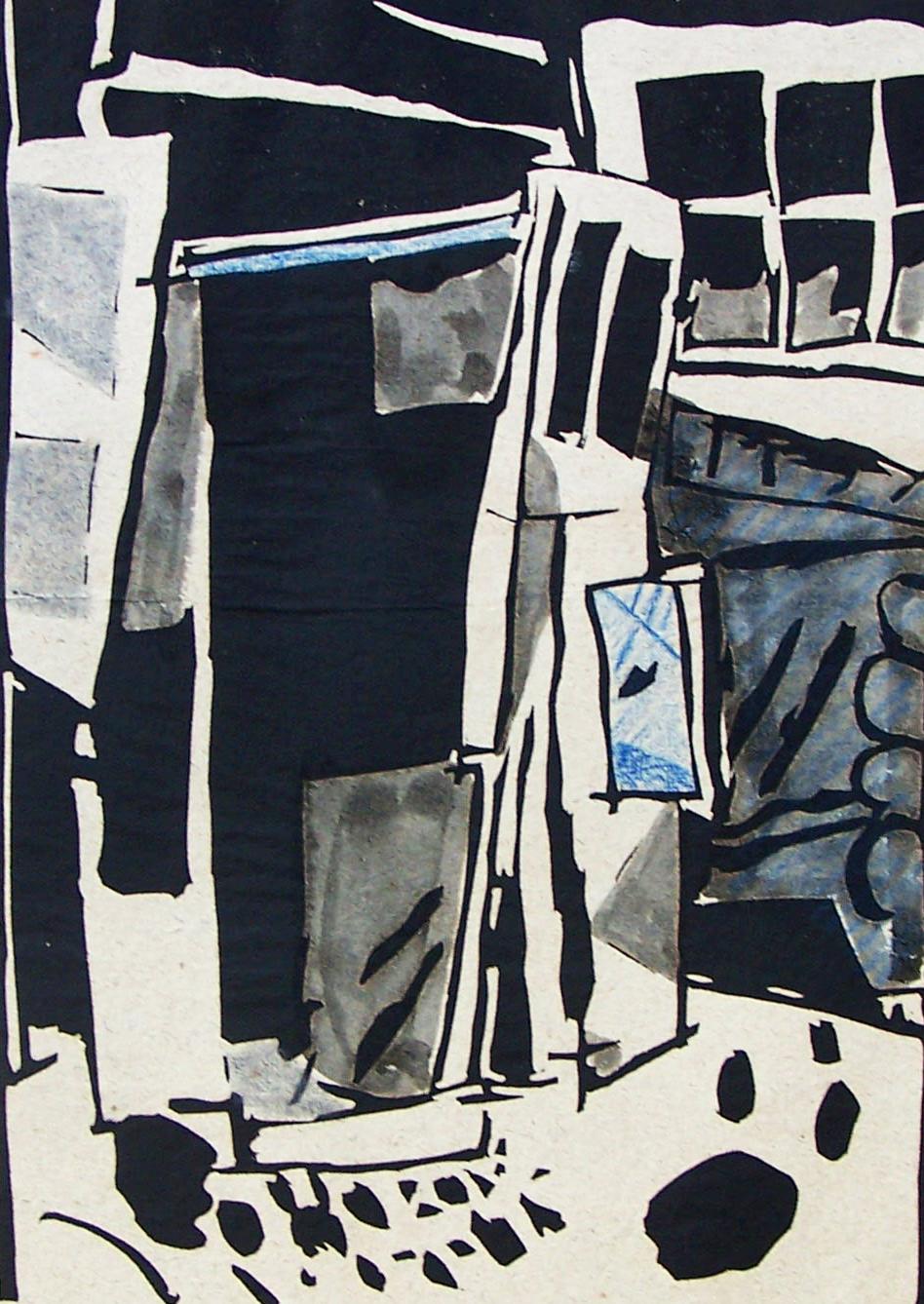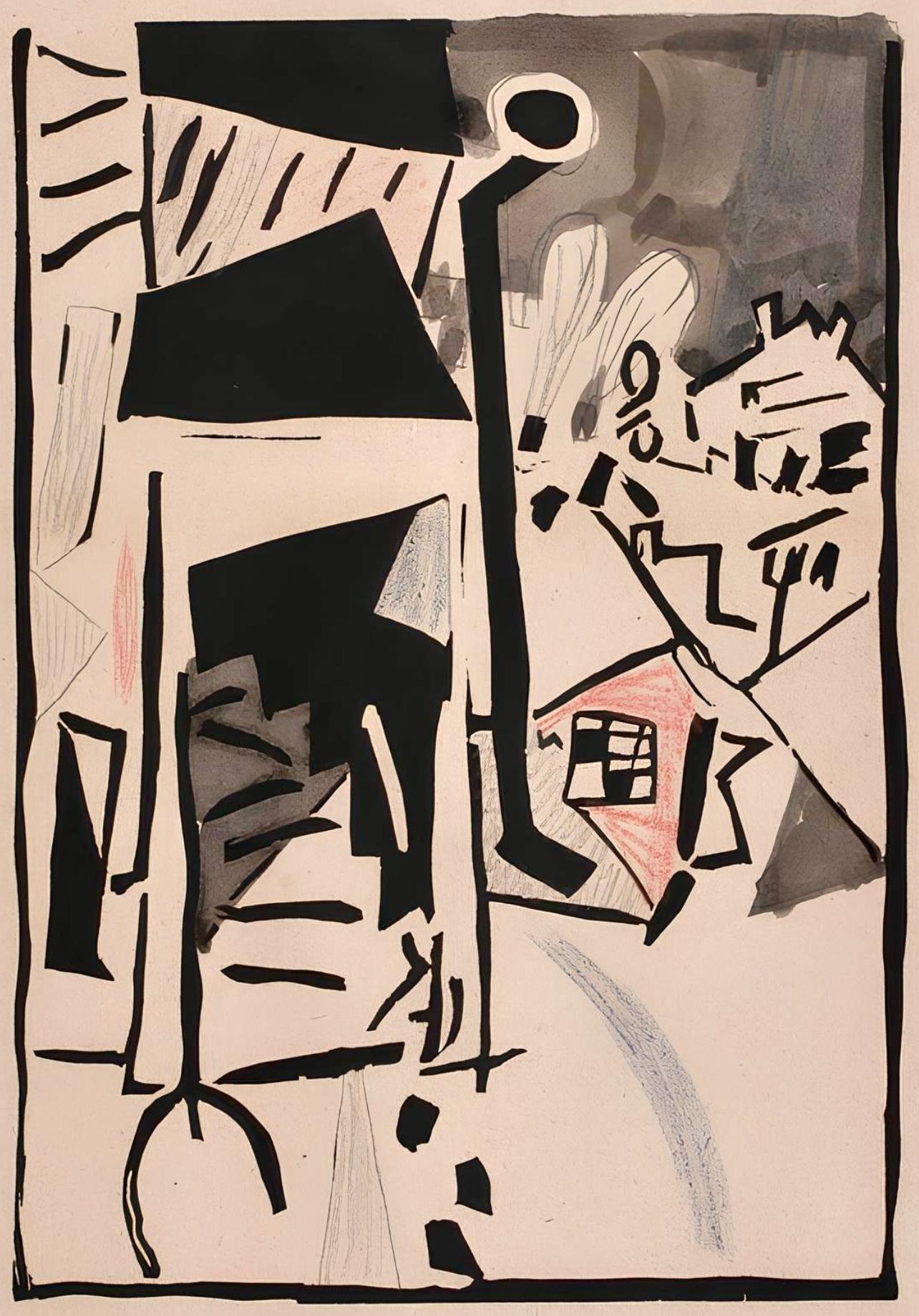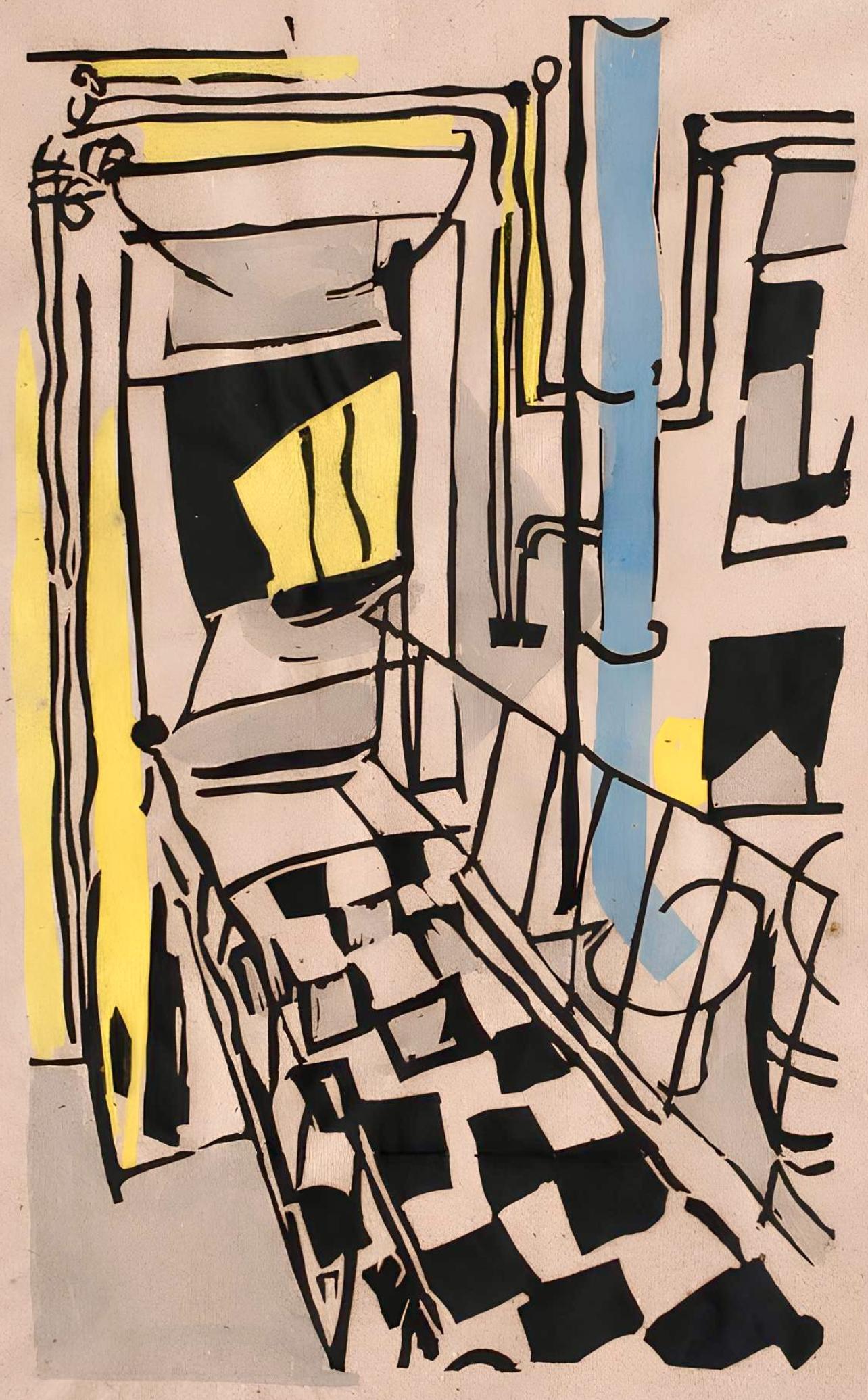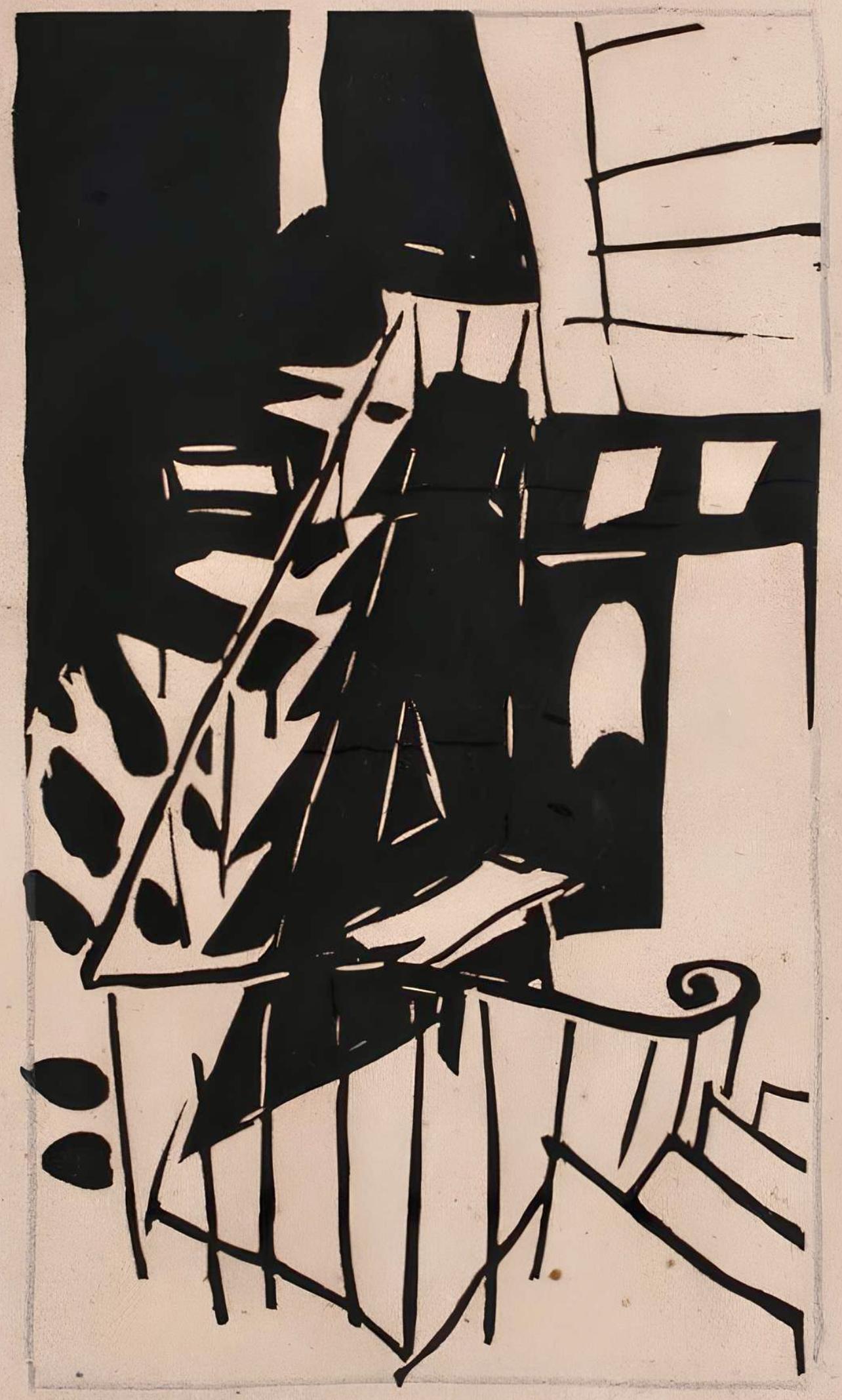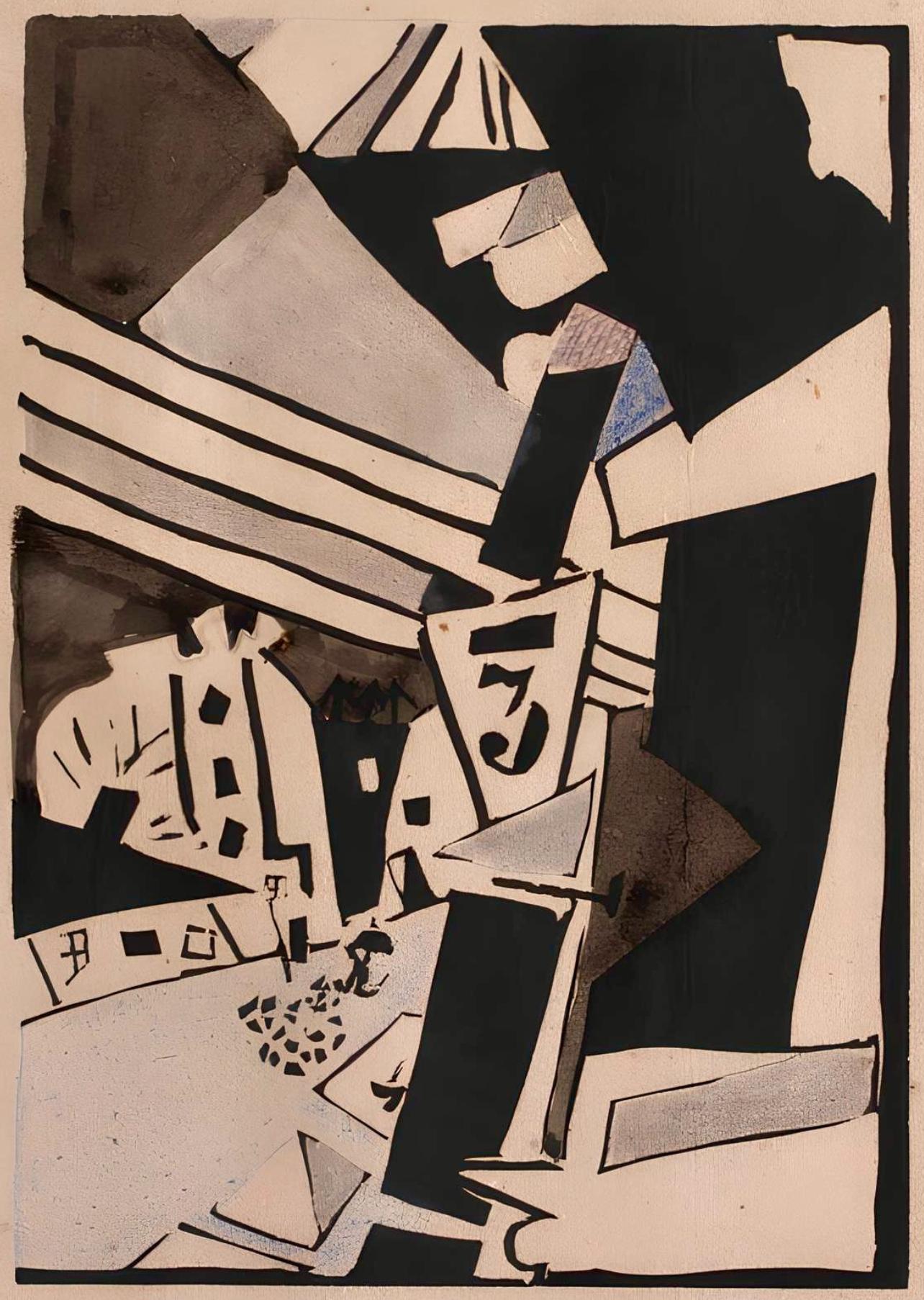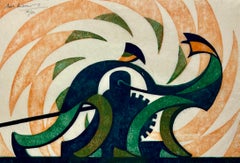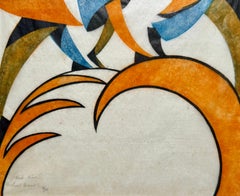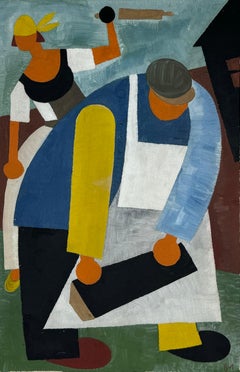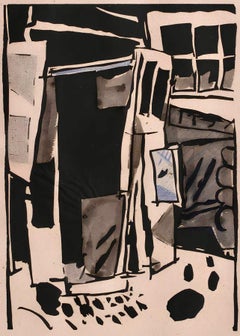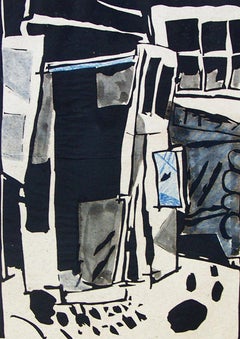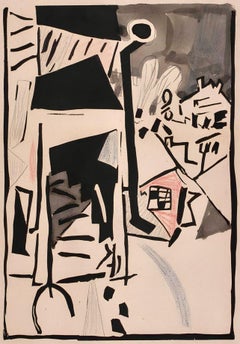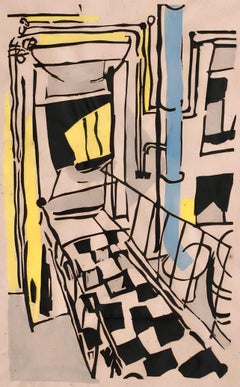Items Similar to "Kiosk in Paris" British Linocut 1/50 European Modernism Swiss Vorticism Deco
Want more images or videos?
Request additional images or videos from the seller
1 of 8
Lill Tschudi"Kiosk in Paris" British Linocut 1/50 European Modernism Swiss Vorticism Deco1933
1933
$23,500
£17,981.89
€20,580.45
CA$33,188.19
A$36,069.86
CHF 19,330.15
MX$437,952.23
NOK 242,678.32
SEK 225,047.26
DKK 153,710.62
About the Item
"Kiosk in Paris" British Linocut 1/50 European Modernism Swiss Vorticism Deco
Lill Tschudi (Swiss, 1911-2004)
Kiosk in Paris (Coppel LT 29)
Linocut printed in brown black, vermilion and bluish grey, 1933, on tissue thin oriental laid paper.
Signed, annotated 'Handdruck' and numbered 1/50 in pencil. Titled in the lower margin in pencil.
Block 220 x 260mm (8 5/8 x 10 1/4in
Sheet 257 x 285mm (10 1/8 x 11 1/4in)
Framed by Bark 15 x 16 1/4 inches
BIO
Lill Tschudi (1911-2001) was a prominent figure in the Grosvenor School of Modern Art* and is known primarily for her colourful and lively linocut work. Her early work explored technological advancement and the dynamism of the modern world. She later focused on sporting themes as her subjects, and after 1945 her style shifted to abstraction.
Lill Tschudi was born in the village of Schwanden, high in the mountains of eastern Switzerland. The village is known for its textile heritage, and Tschudi briefly experimented with designs for textiles when she put certain of her images onto pillow and cushion cases. She is now known almost exclusively, however, for her colour linocut work.
Tschudi was first introduced to the linocut when she saw an exhibition of the colour cuts of animals by Norbertine Bresslern-Roth (1891-1978) whilst still at school. After school she noticed an advertisement in The Studio inviting applications for a training programme specialising in linocuts at The Grosvenor School of Art, London.
Lill Tschudi attended The Grosvenor School briefly, from 1929-30, but throughout her life she maintained a close working relationship with the Grosvenor School linocut* tutor Claude Flight. He encouraged her, supporting her career and acting as a point of liaison in England whilst she worked abroad.
Her early work clearly demonstrates his influence. Flight was inspired by the concerns of the Italian Futurists* and by Vorticism*. He encouraged the depiction of a modern man-made world full of technological advancement. Tschudi explored this subject matter in her famous linocuts of motor-car racing and the London Underground.
From 1931-33, Tschudi lived in Paris and studied with the Cubist artist Andre Lhote, then with the Futurist Gino Severini at the Academie Ronson, and finally under Fernand Lger at the Academie Moderne.
Whilst in Paris she focused on the life of the city; young browsers at a news-and-print stand; bill posters; and for several of her most captivating prints, jazz music. Later on she took sporting themes as her subjects; circus tumblers, gymnasts, cyclists, runners and, like Sybil Andrews, she often depicted men at work.
Tschudi returned to Schwanden, Switzerland in 1935, but she continued to produce linocuts. Over her lifetime Tschudi produced 355 linocuts. She sent work to London regularly and received high critical acclaim. One London critic wrote: she seems to seize activity on the wing, and fix it in her linocuts.
Purchases soon followed from, amongst others, the Vand A and the British Museum. Her work is now held in major print collections around the world and was featured extensively in the (2008) exhibition British Prints from the Machine Age - Rhythms of Modern Life 1914-1939 at the Museum of Fine Arts, Boston, and the Metropolitan Museum of Art, New York.
About the Seller
5.0
Gold Seller
Premium sellers maintaining a 4.3+ rating and 24-hour response times
Established in 2008
1stDibs seller since 2019
196 sales on 1stDibs
Typical response time: <1 hour
- ShippingRetrieving quote...Shipping from: New York, NY
- Return Policy
More From This Seller
View All"Winch" British Linocut Grosvenor School Machine Age 1930 Woman Artist Print
By Sybil Andrews
Located in New York, NY
"Winch" British Linocut Grosvenor School Machine Age 1930 Woman Artist Print
"The Winch" 1930. 7 3/4 x 11 (sight) inches. Linocut in colors on tissue...
Category
1930s Modern Figurative Prints
Materials
Linocut
"Rush Hour" British Modern Mid 20th Century Vorticist European Vorticism Woman
By Sybil Andrews
Located in New York, NY
"Rush Hour" British Modern Mid 20th Century Vorticist European Vorticism Woman
Sybil Andrews CPE (British/Canadian, 1898-1992)
Rush Hour (Coppel SA 11)
Linocut printed in Chinese orange, Chinese blue and black, 1930, on tissue thin oriental laid paper.
Signed, titled and numbered 8/50 in pencil lower left, framed.
Block 209 x 251mm (8 1/4 x 9 7/8in)
Sheet 249 x 310mm (9 3/4 x 12 1/4in)
Framed by Bark 14 1/2 x 16 inches
BIO
Sybil Andrews was a printmaker, painter, graphic artist and educator who was born in Bury St. Edmonds, Suffolk, England. She moved to London (England) in 1922. In 1947, she emigrated to Campbell River (Vancouver Island) British Columbia, Canada, where she worked, taught and lived for the rest of her life. She died at a hospital in Victoria (B.C.)
Her mediums were the colour linocut (1) (most famous), etching, posters, pastels, ink, watercolour, monoprint and oil. Her subjects were human activity (at work, sports, travel, etc.), figures, animals, genre, allegory, architecture and landscape. Her style was Art Deco (see AskART styles), Futurism, Cubism and Vorticism (2). Her work is identified by a simple format, clean lines, distortion, vivid colours, drama and rhythm.
Quote: "The colour linocut was just the medium for me, being interested in dynamics and ideas and patterns... It is impossible to be fussy with lines, you have to simplify, you are forced to simplify your idea to its fundamentals." Andrews produced 76 linocuts in her life, of which 43 were made from 1929 to 1939, which is considered to be her best period.
John Hassall's art correspondence course (1918) was the beginning of her formal art education. She went from there to Heatherley's School of Fine Art (London/1922) where she studied under Henry Massey (see AskART) and met artistic partner Cyril Power (see AskART). At the same time, she studied independently with sculptor Henri Glicenstein (see AskART) who taught her drypoint etching and to draw from life.
She also attended the Grosvenor School of Modern Art (1925). Iain McNab (1890-1967) was Principal and Claude Flight (3) (see AskART) an instructor who had a great influence on her choice of linocut as a primary medium. Some of his other students and her associates were Edith Lawrence (1890-1973), Lill Tschudi (1911-2001), Eileen Mayo (see AskART) and William Greengrass...
Category
1930s Modern Figurative Prints
Materials
Linocut
"Workers" Russian Constructivist 1920s Modern Social Realism Cubism Figurative
Located in New York, NY
"Workers" Russian Constructivist 1920s Modern Social Realism Cubism Figurative
VLADIMIR VASIL’EVICH LEBEDEV (1891-1967)
"Workers"
Gouache on paper
Monog...
Category
1920s Constructivist Figurative Paintings
Materials
Paper, Gouache
The New Cable British Modern Mid 20th Century Vorticist European Vorticism Woman
By Sybil Andrews
Located in New York, NY
The New Cable British Modern Mid 20th Century Vorticist European Vorticism Woman
Sybil Andrews CPE (British/Canadian, 1898-1992)
"The New Cable," 1931
12 x 16 1/2 inches
Color linocut
Signed, titled, inscribed 'Second State', and numbered 13/60 in pencil
Framed: 19 x 24 inches
Literature: Coppel Sa17
Illustrated on page 10 of the catalog
The proposed edition of the first state of the Giant Cable was 50, but only 30 impressions were pulled. Andrews removed the blue background for the second state, which was published under the title The New Cable in an edition of 60.
BIO
Sybil Andrews was a printmaker, painter, graphic artist and educator who was born in Bury St. Edmonds, Suffolk, England. She moved to London (England) in 1922. In 1947, she emigrated to Campbell River (Vancouver Island) British Columbia, Canada, where she worked, taught and lived for the rest of her life. She died at a hospital in Victoria (B.C.)
Her mediums were the colour linocut (1) (most famous), etching, posters, pastels, ink, watercolour, monoprint and oil. Her subjects were human activity (at work, sports, travel, etc.), figures, animals, genre, allegory, architecture and landscape. Her style was Art Deco (see AskART styles), Futurism, Cubism and Vorticism (2). Her work is identified by a simple format, clean lines, distortion, vivid colours, drama and rhythm.
Quote: "The colour linocut was just the medium for me, being interested in dynamics and ideas and patterns... It is impossible to be fussy with lines, you have to simplify, you are forced to simplify your idea to its fundamentals." Andrews produced 76 linocuts in her life, of which 43 were made from 1929 to 1939, which is considered to be her best period.
John Hassall's art correspondence course (1918) was the beginning of her formal art education. She went from there to Heatherley's School of Fine Art (London/1922) where she studied under Henry Massey (see AskART) and met artistic partner Cyril Power (see AskART). At the same time, she studied independently with sculptor Henri Glicenstein (see AskART) who taught her drypoint etching and to draw from life.
She also attended the Grosvenor School of Modern Art (1925). Iain McNab (1890-1967) was Principal and Claude Flight (3) (see AskART) an instructor who had a great influence on her choice of linocut as a primary medium. Some of his other students and her associates were Edith Lawrence (1890-1973), Lill Tschudi (1911-2001), Eileen Mayo (see AskART) and William Greengrass (1896-1970). After emigrating to Canada she taught art continuously until a month before her death.
She was elected a member of the Canadian Painters - Etchers Society (after 1976 the Print and Drawing Council of Canada) in 1951.
She began exhibiting her work in 1921.In 1929 she was included in "The First Exhibition of British Linocuts...
Category
1930s Modern Figurative Prints
Materials
Linocut
"Steel Factory" Cuban Mid 20th Century Modern Drawing WPA Latin Art Industrial
Located in New York, NY
"Steel Factory" Cuban Mid 20th Century Modern Drawing WPA Latin Art Industrial
Ink on paper. 12 x 19 inches. Pogolotti lived in Paris in the 1930s. The drawing here comes from the collection of his Parisian ophthalmologist, Dr. Prokopenko . Unfortunately, the artist lost his eyesight in 1938.
Marcelo Pogolotti (1902–1988) was a Cuban painter...
Category
1930s Modern Figurative Drawings and Watercolors
Materials
Paper, Ink
Original Painting Steel Workers Fabric Design Industrial Deco American Modernism
By Antonio Petruccelli
Located in New York, NY
Original Painting Steel Workers Fabric Design Industrial Deco American Modernism
Antonio Petruccelli (1907 - 1994)
Steel Workers
Textile design
19 1/4 X ...
Category
1930s American Modern Figurative Paintings
Materials
Gouache, Board
You May Also Like
Pougny, Composition, Pougny, dix linogravures originales, 1914-1920 (after)
By Jean Pougny
Located in Southampton, NY
Linocut on vélin vergé ancien paper. Unsigned and unnumbered, as issued. Good condition. Notes: From the folio, Pougny, dix linogravures originales, 1964. Published by Au Vent d'Arle...
Category
1960s Cubist Abstract Prints
Materials
Linocut
$4,076 Sale Price
20% Off
Free Shipping
Portfolio L'Atelier - 10 Linocuts Russian
By Jean Pougny
Located in London, GB
The portfolio consists of 10 linocuts, each printed on a separate sheet and stamp signed with the artist's signature stamp "Pougny".
These original prints were created by Pougny hims...
Category
1910s Interior Prints
Materials
Linocut, Stencil
Pougny, Composition, Pougny, dix linogravures originales, 1914-1920 (after)
By Jean Pougny
Located in Southampton, NY
Linocut on vélin vergé ancien paper. Unsigned and unnumbered, as issued. Good condition. Notes: From the folio, Pougny, dix linogravures originales, 1964. Published by Au Vent d'Arle...
Category
1960s Cubist Abstract Prints
Materials
Linocut
$4,076 Sale Price
20% Off
Free Shipping
Pougny, Composition, Pougny, dix linogravures originales, 1914-1920 (after)
By Jean Pougny
Located in Southampton, NY
Linocut on vélin vergé ancien paper. Unsigned and unnumbered, as issued. Good condition. Notes: From the folio, Pougny, dix linogravures originales, 1964. Published by Au Vent d'Arle...
Category
1960s Cubist Abstract Prints
Materials
Linocut
$4,076 Sale Price
20% Off
Free Shipping
Pougny, Composition, Pougny, dix linogravures originales, 1914-1920 (after)
By Jean Pougny
Located in Southampton, NY
Linocut on vélin vergé ancien paper. Unsigned and unnumbered, as issued. Good condition. Notes: From the folio, Pougny, dix linogravures originales, 1964. Published by Au Vent d'Arle...
Category
1960s Cubist Abstract Prints
Materials
Linocut
$4,076 Sale Price
20% Off
Free Shipping
Pougny, Composition, Pougny, dix linogravures originales, 1914-1920 (after)
By Jean Pougny
Located in Southampton, NY
Linocut on vélin vergé ancien paper. Unsigned and unnumbered, as issued. Good condition. Notes: From the folio, Pougny, dix linogravures originales, 1964. Published by Au Vent d'Arle...
Category
1960s Cubist Abstract Prints
Materials
Linocut
$4,076 Sale Price
20% Off
Free Shipping
More Ways To Browse
Men At Work
Vintage Gymnast
News Stand
George Rouault Woodcut
Gerard Dou
Giacometti Annette
Giorgio Morandi Etching
Goupil Prints
Henry Moore Sculptural Ideas
Hermes Paris Rue Du Faubourg Saint Honore
Hockney Glasses
Hockney Olympic
Homage To Chagall
Howard Smith
Jane Bazinet
Jim Dine Pace Gallery 1980
Kaws Pink Bff
Kaws Signed Print
